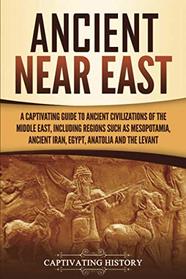Captivating History explains that where water and fertile soil are abundant, there can be life. The Sumerians, as the first documented civilization, also excelled at creating architecture, encouraging literacy, and providing a military system. We see that the habit of the Romans of recruiting soldiers from defeated city-states actually comes from Sargon, centuries earlier.
One of the most interesting (to me) groups of people was the Guti, people from the Zagros Mountains. They brought about the "dark ages of Mesopotamia" because of the turmoil their arrival brought to the area. They seemed to be absolutely barbarian; they knew nothing of domestication of animals, agriculture, or how a civilization operated. And yet, this group maintained control for almost a century.
Hammurabi, leader of Babylon, wrote a new code of law. He initiated the idea that an accused person was innocent until proven guilty. I thought the explanation of the idea of the 'cupbearer' during the Assyrian Empire was an interesting one. However, the Babylonian Empire did not last long after Hammurabi (and his son's) deaths.
It is hard to imagine that one pharaoh would go against centuries of tradition, but Akhenaten decided to form a monotheistic religion, to the god Aten. He must have been extremely egotistical to have tried that. He also created a new capital. However, one of the sons of Akhenaten, King Tutankhamun, returned the country to the old deities and rebuilt the old temples. Obviously, the people were unhappy with the new religion because eventually all of Akhenaten's statues were defaced or removed.
Frankly, I enjoyed the later chapters more than the first. Because so much of the ancient history of the Near East is conjecture, ongoing archaeology, or best guesses, a long narration of one (probable) king after another is of limited interest to me. However, when the work talks about the lives of the people (including those of various classes) and their religions, I find that more interesting.
One of the things about reading ancient history, we see how things became 'that's just how things are done.' We can see that kings intermarried with other groups for alliances and safety (political marriages). I was surprised to learn that the major deities were worshipped by the kings and the commoners paid more attention to personal gods.
One of the most interesting (to me) groups of people was the Guti, people from the Zagros Mountains. They brought about the "dark ages of Mesopotamia" because of the turmoil their arrival brought to the area. They seemed to be absolutely barbarian; they knew nothing of domestication of animals, agriculture, or how a civilization operated. And yet, this group maintained control for almost a century.
Hammurabi, leader of Babylon, wrote a new code of law. He initiated the idea that an accused person was innocent until proven guilty. I thought the explanation of the idea of the 'cupbearer' during the Assyrian Empire was an interesting one. However, the Babylonian Empire did not last long after Hammurabi (and his son's) deaths.
It is hard to imagine that one pharaoh would go against centuries of tradition, but Akhenaten decided to form a monotheistic religion, to the god Aten. He must have been extremely egotistical to have tried that. He also created a new capital. However, one of the sons of Akhenaten, King Tutankhamun, returned the country to the old deities and rebuilt the old temples. Obviously, the people were unhappy with the new religion because eventually all of Akhenaten's statues were defaced or removed.
Frankly, I enjoyed the later chapters more than the first. Because so much of the ancient history of the Near East is conjecture, ongoing archaeology, or best guesses, a long narration of one (probable) king after another is of limited interest to me. However, when the work talks about the lives of the people (including those of various classes) and their religions, I find that more interesting.
One of the things about reading ancient history, we see how things became 'that's just how things are done.' We can see that kings intermarried with other groups for alliances and safety (political marriages). I was surprised to learn that the major deities were worshipped by the kings and the commoners paid more attention to personal gods.




